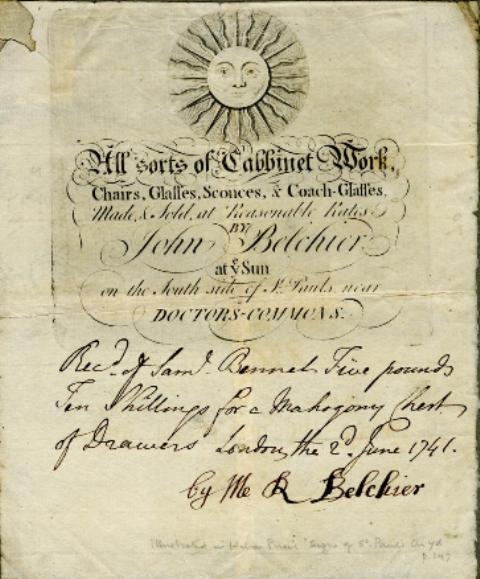
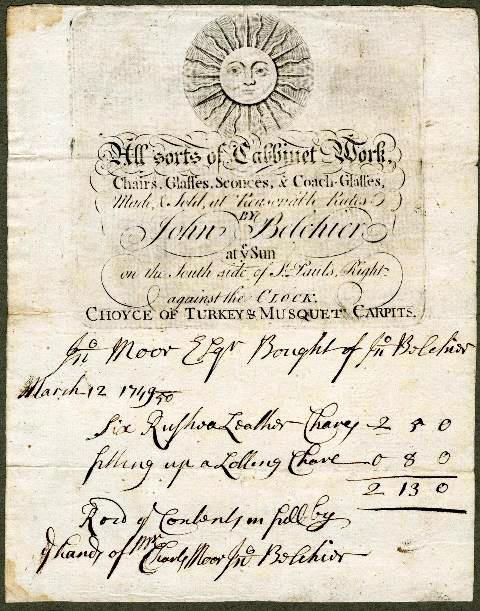
Belchier, John (1699-1753)
Last updated on 10 January 2022
‘The Sun’, south side of St Paul's Churchyard, London; cabinet maker (fl.1699-d. 1753)
The son of an apothecary from Deddington in Oxfordshire, John Belchier was apprenticed through the London Joiners' Company on 2 January 1699/1700. His father by this time was deceased. He was bound to John Belchier who originally came from Barford St John, an adjacent village to Deddington and presumably related (perhaps his uncle) to serve his apprenticeship. He gained the freedom through servitude on 9 September 1707 and by the autumn of 1713 had bound his first apprentice, also called John Belchier. Their relationship is uncertain but because his apprenticeship indenture states he was the 'son of John Belchier' he may have been his cousin, the son of his first master. Two further apprentices are recorded: Thomas Atkinson in June 1741 and William Albrook in November 1741. Precisely when he was established at 'The Sun' on the south side of St. Paul's Churchyard is yet to be determined, but the first known record is on the 26 July 1717 when insurance was effected ‘for goods and merchandise in his said Dwelling House’.
The most significant commission known to have been undertaken by Belchier was for John Meller at Erddig, Wales, a house which he acquired in 1716. He used Simon Yorke, his nephew, as his agent in London to order and supervise the furnishing of the house, which passed to him in 1723 on the death of his uncle. The most impressive piece of furniture in the house is the State Bed which was purchased in 1720. The bed frame with its carved and gilt gesso work is possibly by Belchier, the upholstery work being undertaken by a ‘Mr Hunt’, probably John Hutt, a tradesman whose workshops were also in St Paul's Churchyard. The eagles’ heads on the tester of the bed closely compare with those on gilt pier glasses supplied in 1723 and 1726 at £36 and £50 respectively for the two best bedchambers.
A pair of gilt girandoles with glass arms were supplied by Belchier on 25 August 1724 at a cost of £14 each. Apart from the bed and mirrors, a glass-topped table with the arms of John Meller supplied by Belchier on 6 June 1726 also survives in the house. These items are part of the substantial commissions placed with Belchier at this period. His bill covering November 1722 to January 1726 amounted to £262 12s. At the same period as he was working on furnishings for Erddig, he received orders for glass for St. Paul's Cathedral. Accounts dated December 1724 to January 1725 record the supplying of 8 glasses 25 inches square at £8, and 27 others 25 by 18 inches at 16s each (£21 12s). Two fine japanned desks and bookcase at Erddig are often attributed to Belchier, although they are undocumented. Similar desks and bookcases are often attributed to Belchier on the strength of this association.
Regular customers in the 1730s and 40s were the Purefoy family of Shalston, Buckinghamshire. A letter survives from Elizabeth Purefoy dated 11 January 1735 regarding the supply of ‘a glass in a gold frame’. The details provided suggest that this was a chimney glass which was still present in the house in 1950. It was charged at £3 16s. By a letter dated 8 February 1743 an order was sent for ‘a round neat light mahogany folding table with four legs, two of them to draw out and hold up ye ffolds’. Henry Purefoy, Elizabeth's son, recorded on 18 July 1749 the receipt of an artist's or architect's table for which £3 10s was paid. Of other commissions little is known. Two receipts survive written on trade bills and show that a varied trade was carried on. Items recorded on them include a ‘tea box’, ‘a Claw table with two tops’, ‘A Round Board’ and a mahogany chest of drawers.
Some of Belchier's labelled furniture survives and at least three different styles of label are known (illus. Gilbert (1996), figs 61-72). The known labelled pieces are all either japanned or veneered walnut, except for a mahogany pedimented bookcase and padouk kneehole dressing table, and all appear to date from the period 1720-1750. Some similar cabinets stamped with the impressed initials ‘I. B.’ may also be of his manufacture.
One of his trade bills indicates that he made and supplied ‘All sorts of Cabinet Work,/ Chairs, Glasses, Sconces, & Coach Glasses’. Another trade bill with different wording stated that he ‘Grinds & Makes-up,/ all sorts of fine Peer & Chim/ney Glasses and Glass Sconces,/ Likewise all Cabbinet Makers Goods’. He also indicated that he could offer ‘Great choice of all Ready Made’. Two of his bills are in the Heal's Collection at the British Museum. The first dating from June 1741 is receipted by R. Belchier.
Image
bill
Copyright (Attribution/Credit)
© The Trustees of the British Museum
Bill from John Belchier at ye Sun on the South side of St. Pauls near Doctors-Commons 'Recd of Sam Bennet Five Pounds Ten Shillings for a Mahogany Chest of Drawers London the 2d June 1741 by Me R Belchier', 1741 [Heal,28.9]. © The Trustees of the British Museum
The second bill dated March 1749/50 also includes a 'Choyce of Turkey & Musquet Carpets.
Image
Trade card used as a receipt
Bill from John Belchier at ye Sun to 'Jn Moor Esqr Bought of Jn Belchier March 12 1749/50 Six Rushea Leather Chares £2 5s Filling up a Lolling Chare 8s £2 13s. Recd ye Contents in full by ye hands of Mr Charles Moor Jn Belchier', 1750 [Heal,28.8]. © The Trustees of the British Museum
The death of John Belchier announced in the London Evening Post on 23 March 1753, described him as ‘for many years past a very eminent cabinetmaker aged near 70 at his house in St. Paul's Churchyard’. He was also stated to be kinsman of William Belchier, one of the MPs for the borough of Southwark. His successor at the sign of ‘The Sun’, was his former apprentice, Thomas Atkinson.
The relationships between John Belchier and others with the same surname are unclear. The R. Belchier who signed the bill of 1741 was presumably a relative, perhaps a son or a grandson, but that is unknown. The relationship to Thomas Belchier, a cabinet maker who subscribed to Chippendale’s Director (1754) is also unknown, however, one of John Belchier's apprentices from the 1720s, Caesar Crouch (who also subscribed to Chippendale's Director in 1754), helped to organise an appeal for funds to replace tools belonging to Chippendale's journeymen that were destroyed in a fire in his workshop (1755).
Image
Invitation
Engraved invitation inscribed 'T. Chippendale INV M. Darly Sulp Northum'd Court Strand', 1755. Published in C. Gilbert, The Life and Work of Thomas Chippendale (1978), plate 12.
That Matthew Darly designed and printed an engraved invitation for the occasion held at Caesar Crouch's premises the 'Black Swan' on the south side of St Paul's Churchyard (a near neighbour to 'The Sun'), may indicate at least a personal relationship between these cabinet makers.
Source: DEFM; Joiners’ Company archives; Gilbert, Pictorial Dictionary of Marked London Furniture 1700-1840 (1996); Bowett, English Furniture from Charles II to George II (2001).
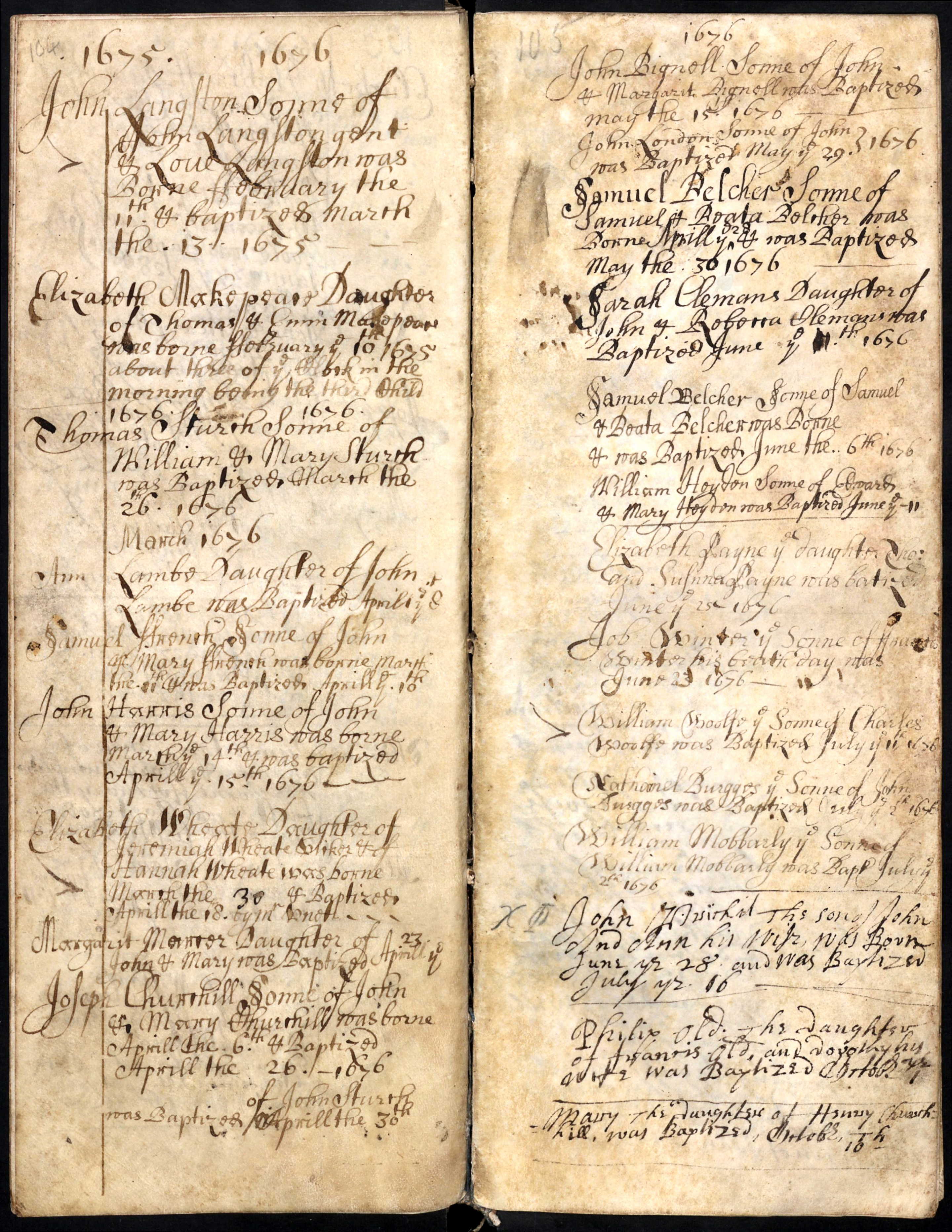
Samuel Belcher Sonne of Samuel & Beata Belcher was Borne April ye 27 & was Baptized May the 30 1676
...
Samuel Belcher Sonne of Samuel & Beata Belcher was Borne & Baptized June the 6th 1676


Belchier, John (1699-1753)
Last updated on 10 January 2022
‘The Sun’, south side of St Paul's Churchyard, London; cabinet maker (fl.1699-d. 1753)
The son of an apothecary from Deddington in Oxfordshire, John Belchier was apprenticed through the London Joiners' Company on 2 January 1699/1700. His father by this time was deceased. He was bound to John Belchier who originally came from Barford St John, an adjacent village to Deddington and presumably related (perhaps his uncle) to serve his apprenticeship. He gained the freedom through servitude on 9 September 1707 and by the autumn of 1713 had bound his first apprentice, also called John Belchier. Their relationship is uncertain but because his apprenticeship indenture states he was the 'son of John Belchier' he may have been his cousin, the son of his first master. Two further apprentices are recorded: Thomas Atkinson in June 1741 and William Albrook in November 1741. Precisely when he was established at 'The Sun' on the south side of St. Paul's Churchyard is yet to be determined, but the first known record is on the 26 July 1717 when insurance was effected ‘for goods and merchandise in his said Dwelling House’.
The most significant commission known to have been undertaken by Belchier was for John Meller at Erddig, Wales, a house which he acquired in 1716. He used Simon Yorke, his nephew, as his agent in London to order and supervise the furnishing of the house, which passed to him in 1723 on the death of his uncle. The most impressive piece of furniture in the house is the State Bed which was purchased in 1720. The bed frame with its carved and gilt gesso work is possibly by Belchier, the upholstery work being undertaken by a ‘Mr Hunt’, probably John Hutt, a tradesman whose workshops were also in St Paul's Churchyard. The eagles’ heads on the tester of the bed closely compare with those on gilt pier glasses supplied in 1723 and 1726 at £36 and £50 respectively for the two best bedchambers.
A pair of gilt girandoles with glass arms were supplied by Belchier on 25 August 1724 at a cost of £14 each. Apart from the bed and mirrors, a glass-topped table with the arms of John Meller supplied by Belchier on 6 June 1726 also survives in the house. These items are part of the substantial commissions placed with Belchier at this period. His bill covering November 1722 to January 1726 amounted to £262 12s. At the same period as he was working on furnishings for Erddig, he received orders for glass for St. Paul's Cathedral. Accounts dated December 1724 to January 1725 record the supplying of 8 glasses 25 inches square at £8, and 27 others 25 by 18 inches at 16s each (£21 12s). Two fine japanned desks and bookcase at Erddig are often attributed to Belchier, although they are undocumented. Similar desks and bookcases are often attributed to Belchier on the strength of this association.
Regular customers in the 1730s and 40s were the Purefoy family of Shalston, Buckinghamshire. A letter survives from Elizabeth Purefoy dated 11 January 1735 regarding the supply of ‘a glass in a gold frame’. The details provided suggest that this was a chimney glass which was still present in the house in 1950. It was charged at £3 16s. By a letter dated 8 February 1743 an order was sent for ‘a round neat light mahogany folding table with four legs, two of them to draw out and hold up ye ffolds’. Henry Purefoy, Elizabeth's son, recorded on 18 July 1749 the receipt of an artist's or architect's table for which £3 10s was paid. Of other commissions little is known. Two receipts survive written on trade bills and show that a varied trade was carried on. Items recorded on them include a ‘tea box’, ‘a Claw table with two tops’, ‘A Round Board’ and a mahogany chest of drawers.
Some of Belchier's labelled furniture survives and at least three different styles of label are known (illus. Gilbert (1996), figs 61-72). The known labelled pieces are all either japanned or veneered walnut, except for a mahogany pedimented bookcase and padouk kneehole dressing table, and all appear to date from the period 1720-1750. Some similar cabinets stamped with the impressed initials ‘I. B.’ may also be of his manufacture.
One of his trade bills indicates that he made and supplied ‘All sorts of Cabinet Work,/ Chairs, Glasses, Sconces, & Coach Glasses’. Another trade bill with different wording stated that he ‘Grinds & Makes-up,/ all sorts of fine Peer & Chim/ney Glasses and Glass Sconces,/ Likewise all Cabbinet Makers Goods’. He also indicated that he could offer ‘Great choice of all Ready Made’. Two of his bills are in the Heal's Collection at the British Museum. The first dating from June 1741 is receipted by R. Belchier.
Image
bill
Copyright (Attribution/Credit)
© The Trustees of the British Museum
Bill from John Belchier at ye Sun on the South side of St. Pauls near Doctors-Commons 'Recd of Sam Bennet Five Pounds Ten Shillings for a Mahogany Chest of Drawers London the 2d June 1741 by Me R Belchier', 1741 [Heal,28.9]. © The Trustees of the British Museum
The second bill dated March 1749/50 also includes a 'Choyce of Turkey & Musquet Carpets.
Image
Trade card used as a receipt
Bill from John Belchier at ye Sun to 'Jn Moor Esqr Bought of Jn Belchier March 12 1749/50 Six Rushea Leather Chares £2 5s Filling up a Lolling Chare 8s £2 13s. Recd ye Contents in full by ye hands of Mr Charles Moor Jn Belchier', 1750 [Heal,28.8]. © The Trustees of the British Museum
The death of John Belchier announced in the London Evening Post on 23 March 1753, described him as ‘for many years past a very eminent cabinetmaker aged near 70 at his house in St. Paul's Churchyard’. He was also stated to be kinsman of William Belchier, one of the MPs for the borough of Southwark. His successor at the sign of ‘The Sun’, was his former apprentice, Thomas Atkinson.
The relationships between John Belchier and others with the same surname are unclear. The R. Belchier who signed the bill of 1741 was presumably a relative, perhaps a son or a grandson, but that is unknown. The relationship to Thomas Belchier, a cabinet maker who subscribed to Chippendale’s Director (1754) is also unknown, however, one of John Belchier's apprentices from the 1720s, Caesar Crouch (who also subscribed to Chippendale's Director in 1754), helped to organise an appeal for funds to replace tools belonging to Chippendale's journeymen that were destroyed in a fire in his workshop (1755).
Image
Invitation
Engraved invitation inscribed 'T. Chippendale INV M. Darly Sulp Northum'd Court Strand', 1755. Published in C. Gilbert, The Life and Work of Thomas Chippendale (1978), plate 12.
That Matthew Darly designed and printed an engraved invitation for the occasion held at Caesar Crouch's premises the 'Black Swan' on the south side of St Paul's Churchyard (a near neighbour to 'The Sun'), may indicate at least a personal relationship between these cabinet makers.
Source: DEFM; Joiners’ Company archives; Gilbert, Pictorial Dictionary of Marked London Furniture 1700-1840 (1996); Bowett, English Furniture from Charles II to George II (2001).
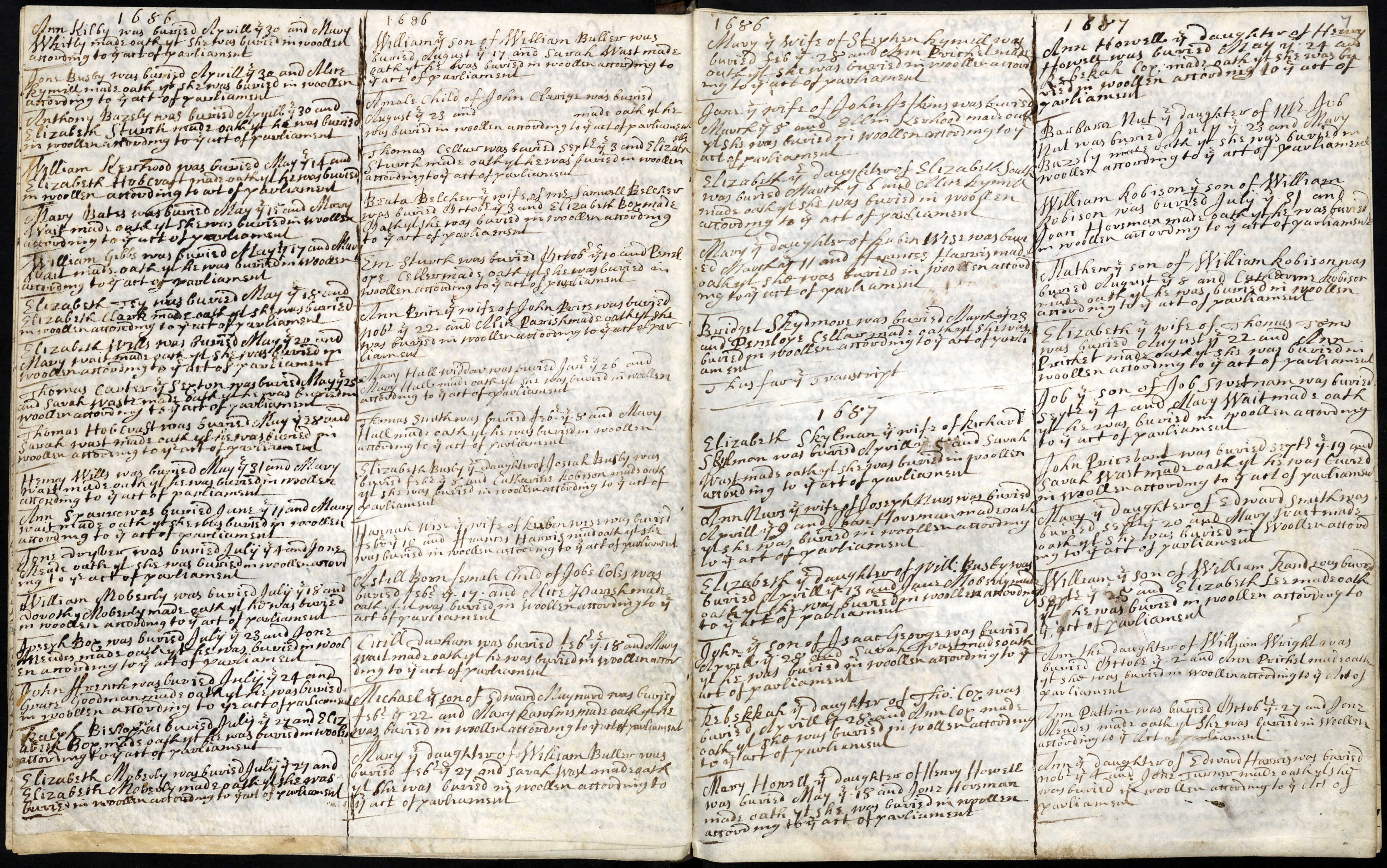
Beata Belcher ye wife of Mr Samuell Belcher was buried October ye 3 and Elizabeth Both made Oath that she was buried in woollen according to ye act of parliament
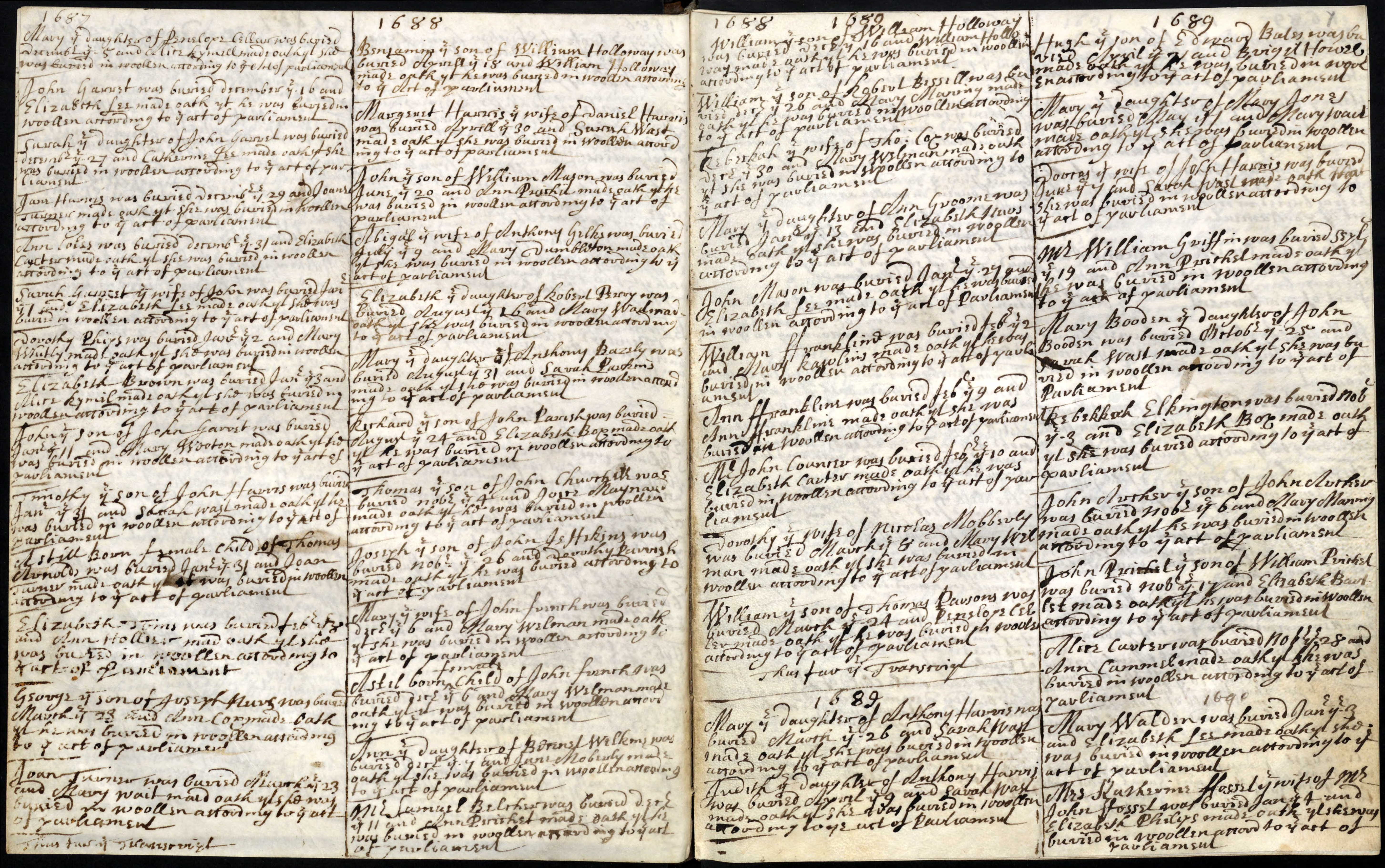
Mr Samuel Belchier was buried decr ye 11 and Ann Parishet made oath that he was buried in woollen according to ye act of parliament
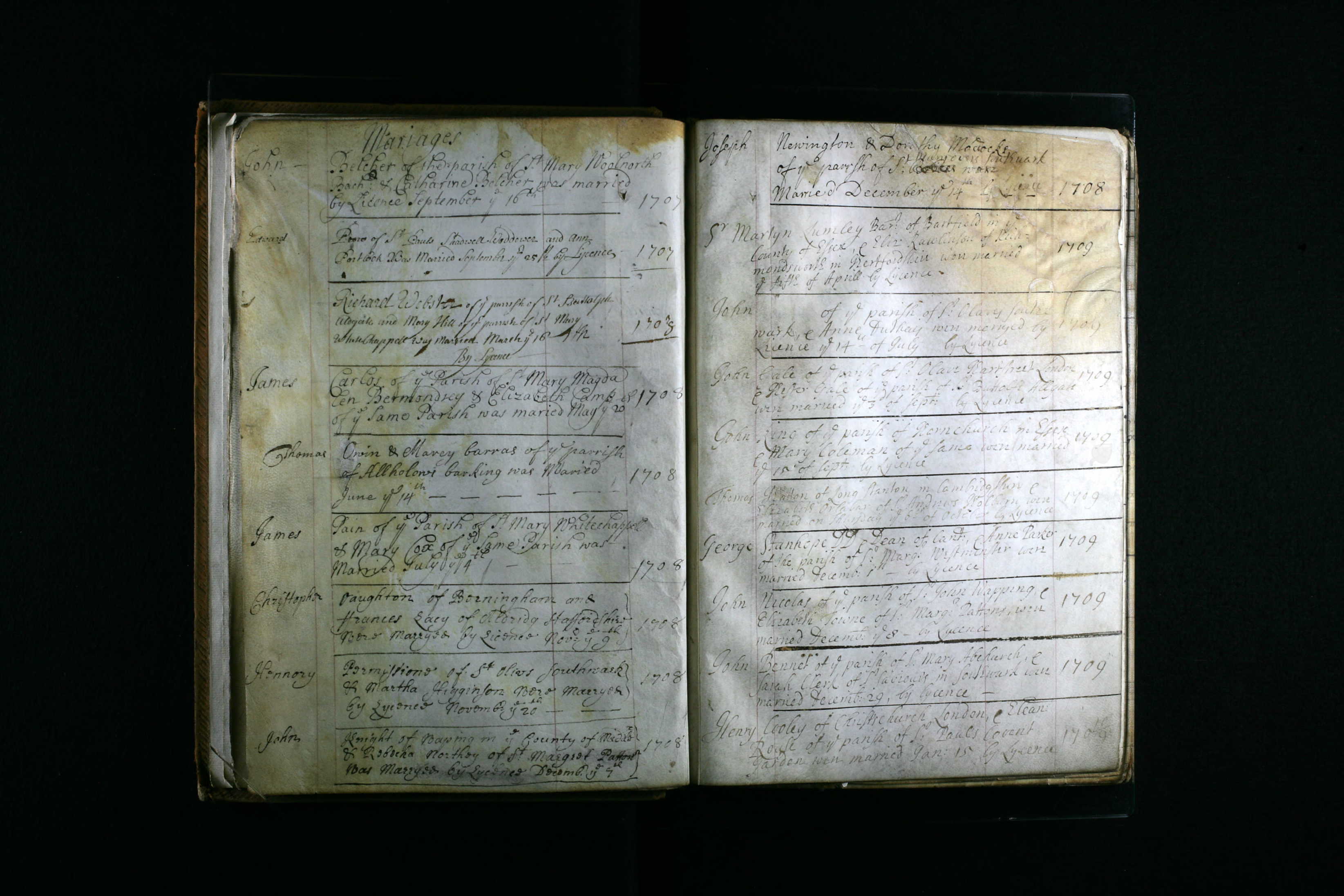
Mariages
John - Belcher of the parish of St Mary Woolnorth
Bach : & Catharine Belcher was married
by License September ye 16th